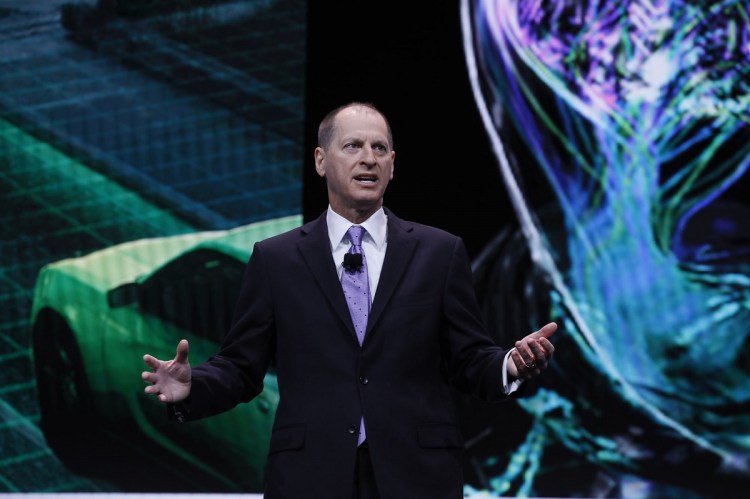Gary Shapiro is CEO of the Consumer Technology Association, the trade group that puts on tech’s biggest trade show: CES. Another big show is coming in a couple of weeks, and for the third time Shapiro is showing up with a new book, this one dubbed Ninja Future: Secrets to Success in the New World of Innovation.
Running the CTA and CES gives Shapiro a unique perch. This year, the trade show will cover more than 2.8 million square feet of exhibit space, a new record for CES. Total attendance is expected to reach over 180,000, compared to the audited number of 182,198 in 2018. International attendance will be more than 60,000, compared to 63,784 last year. There will be more than 25 marketplaces, covering everything from robotics to drones. The number of exhibitors is expected to be over 4,500, and the number of startups in the Eureka Park section of the show is expected to top 1,100. All of which is to say it should be a good year.
Shapiro’s view of the tech landscape inspired him to write about how companies need to move fast, spot trends, embrace diversity, and deal with rapid changes and disruptions. He teamed up with CTA communications director to write a guide to help executives and government leaders navigate the future. The book outlines strategies for success and gave us a jumping off point for talking about technology, CES, and our own personal interests in what the future will bring.
Here’s an edited transcript of our interview.
June 5th: The AI Audit in NYC
Join us next week in NYC to engage with top executive leaders, delving into strategies for auditing AI models to ensure fairness, optimal performance, and ethical compliance across diverse organizations. Secure your attendance for this exclusive invite-only event.

Above: Gary Shapiro, CEO of the Consumer Technology Association, has written three books on the tech landscape.
VentureBeat: It looks like the observations in your book are gathered by having that perch on the whole industry at CES. How many books is this for you now?
Gary Shapiro: This is my third. It’s the second in the Ninja series. The last Ninja book did so well that the publisher wanted another one. The last book was focused more on what I learned from successful businesspeople. This is more about technology and the future and where things are going. It does, as you’ve seen, contain a lot of personal stories, but it also focuses on areas of likely and certain technology, like AI, robots, health care, AR/VR, blockchain, and self-driving. It’s aimed at people who want to understand where technology is going so they can do better, whether it’s people in government, in companies, or just starting businesses to live their lives.
For someone like you who already knows about all this stuff, a couple of chapters are going to be like, “Well, so what?” But as you go further into the book there’s more personal thoughts, and what government should be doing. Because of who we are and what we do, globally and in the U.S., we’re often in a position of critiquing and helping governments and saying, “If you want to be innovative, this is what you have to do.”
VentureBeat: Did you find this was easier for you to do in some ways, or harder than the other books?
Shapiro: If you get to the very end, I tell the truth about Rachel Horn [CTA communications director]. She’s the one who came to me and said, “You’ve written all these op-eds. There’s a book here.” I said, “I have a thousand ideas, but I don’t have a book idea.” She said, “Let me put something together based on what you’ve written and organize it.” She created the first draft, if you want to know the truth. But then there’s a lot of stuff we supplemented with, personal stories and so on.
There’s stuff that’s been published as articles in there, which we have permission to do, and then a lot that was added, personal stories and wrapping. Numerous people put their hands on it. In the policy world I probably let in a few too many people, because it got more idealistic than I wanted it to.
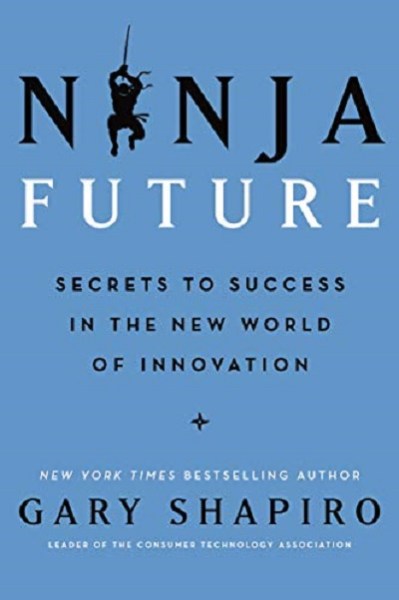
Above: The Ninja Future is about moving fast in an innovative world.
VentureBeat: It’s a broad survey of where things are. I think that’s always helpful, to have those sweeping views.
Shapiro: When I wrote my second book, I found out that a lot of people who waited in line for an autograph, they’d read the first book and they talked about how it influenced their lives. They went to school or quit their job or did all this stuff. That encouraged me to write the third book. I’d learned that it really affected people. What I look forward to at CES, when I do the first signings, is hearing from people about how the second book affected to them. I talk in a lot of places around the world, so it’s nice to have a book. Rachel also convinced me that we have to go to Davos, so we’re going to Davos.
VentureBeat: I like how, early on, there’s something on the aging population. My own mother is 85, and she has severe dementia. There’s no technology out there created for these people. Even modern phones–we all think they’re easy to use, but she has a terrible time trying to make a phone call to me now.
Shapiro: My grandmother had [Alzheimers] for 13 years before she passed away. Honestly, by the end it was a relief. I’ve had memory issues my whole life, and I’ve dealt with that. But if you haven’t checked out how music can impact people–you don’t really know that someone has Alzheimer’s until they die and then they can look at the brain. But it doesn’t really matter, whether it’s severe dementia or Alzheimer’s. But with Alzheimer’s, at least, if you play them music, you’ll be shocked.
That’s one of the most important things in the book, to me. If you can help anyone do that, it changes their life. If you watch the documentary, “Alive Inside,” it’s really helpful. It matters. Honestly, there are some provinces and states that are now paying for iPods to be loaded up with music. There’s only one drug, and it barely does anything. It’s expensive as can be. I’m hoping there can be some breakthroughs with Alzheimer’s. It’s a very cruel disease. It’s a cause a lot of us adopted here. Our CFO and COO is on the board of one of the Alzheimer’s groups. I’ve been supporting a different one. But there’s nothing–there’s no real breakthroughs at this point.
In terms of technology–I make this a personal cause. Facial recognition, to me, is not only good for preventing crime, as is done in London. I know there are privacy implications. But for people like me–the reason I’m in the trade show world, honestly, is you have to wear a badge. I can tell who you are by looking at you. I also have a lot of insecurity in that area, to be honest.
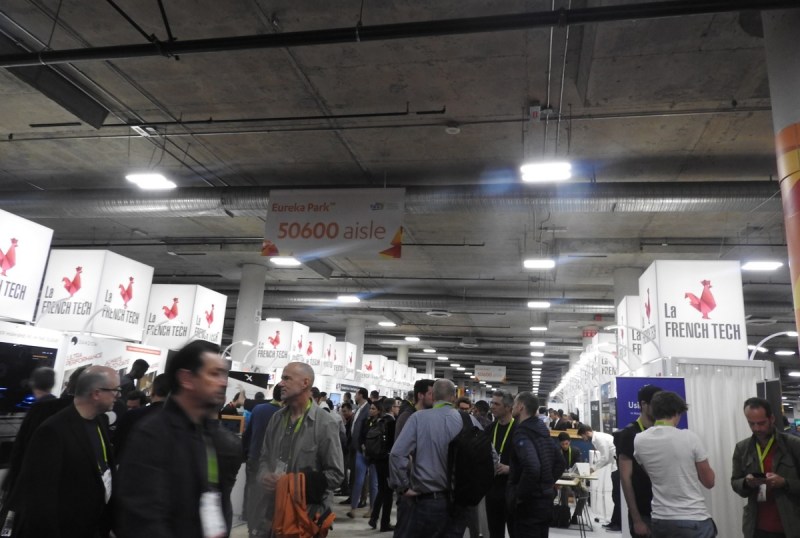
Above: Eureka Park at the Sands Expo at CES 2018. The area had more than 800 startups, including many from France.
VentureBeat: There are 180,000 people who’ll recognize you, and you probably won’t recognize them.
Shapiro: That is an issue, and I’m not going lie. That is an issue. Everyone thinks that I’ve talked to them or send a thank-you letter for being a speaker–we have 1,100 speakers. I’ve talked to members of Congress who have this issue. Bill Clinton was extraordinarily unique in his ability to remember everyone’s name. I think Obama was pretty good.
But I just turned over this technology that’s really cool. Bose has something they just put on their website. They have these eyeglasses you wear with an earpiece in them. It looks like normal eyeglasses, because of the way that bone conducts sound. But you can actually have someone telling you, through the device, who people are. The facial recognition, to me, is better, because it can be automatic. You can just have it on.
There’s another category of people that would work for, which is people who are visually impaired. They’d benefit from facial recognition technology as well. For those people there’s a whole bunch of new technologies coming. But the facial recognition thing, at this point, I’d say is a failure in the U.S., because no one’s really doing anything after what happened with Google Glass. They took it out before they even introduced the product because there was so much outcry.
A lot of these things that apply to the privacy goings-on in the world generally–a lot of privacy advocates are very vocal. But I think people want a lot of these things.
VentureBeat: For privacy purposes, maybe the thing you need to know is just, “Have I met this person?” Rather than telling you who everybody is.
Shapiro: Are they on LinkedIn or Facebook? If you could connect with them there, that would take care of a lot of my problems. One of the things we’re really focusing on at CES this year is a new app that’s a million times better than what we’ve done before. It tells you about the people that are LinkedIn friends of yours, if they’re going to a certain session. That would be something, if it was totally permission-based.
Where the jobs will be
VentureBeat: One thing that I didn’t see, but I wonder what you think of it, is something I call a leisure economy, where more and more people will get paid to play games. You have esports athletes, YouTubers, live streamers, cosplayers, all these people who are applying their interest or skill around games to generate attention for themselves and get income as a result. To me that seems like these are jobs that did not exist 10 or five years ago.
Shapiro: It’s a good point. We do have stuff around esports that we haven’t had before. There’s a HyperX esports and gaming track in the Sands. That’s definitely a trend. It goes to a whole range of issues. I didn’t touch on that in the book. There’s a lot of questions people are debating. There was a community in the U.S. that just voted to give every resident a minimum amount of money per year, even if they weren’t working.
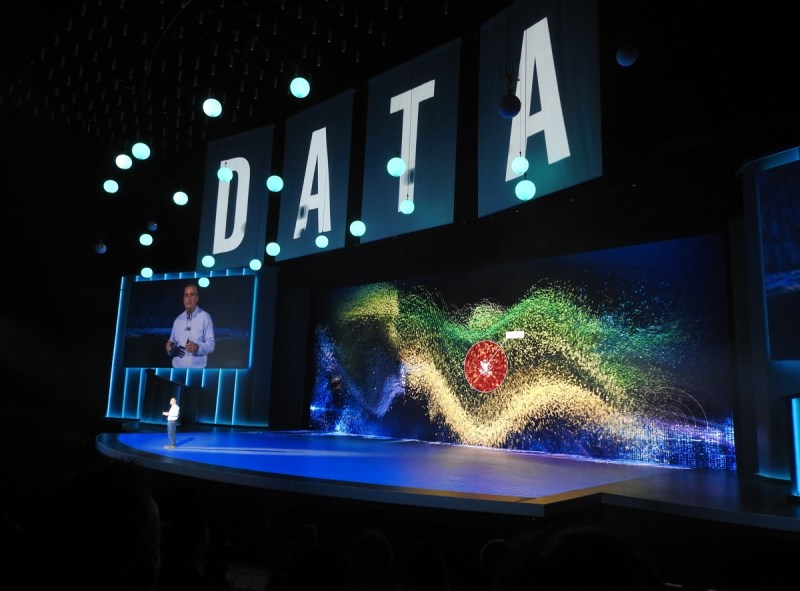
Above: Intel’s CES 2018 keynote had some amazing visuals on a giant screen. This image is a visualization of a trove of data.
VentureBeat: A basic income, yeah.
Shapiro: There’s the whole issue around AI and robotics. If you believe people will be working fewer hours and more leisure time–you could be right, but I also think you could be wrong. Every new technology that people have said would give us more leisure time, it hasn’t. There are computer programs doing journalists’ jobs now on Wall Street, doing earnings announcements. But do you think any journalist is doing less work now because of technology? They may be getting paid less, but I think journalists are working more.
Take self-driving cars. Someone’s going to have to clean those cars, service those cars. The average car today is only used five percent of the time. If a car is used 95 percent of the time–this doesn’t mean cars aren’t going to break down. If you go to a sharing economy for cars, people are still slobs. Somebody’s going to have to clean them. Someone’s going to have to get the packages and the people, especially older people, the last few feet from the car to do the door.
So many things have happened in the past where all these new jobs are created that we don’t anticipate. Those are just the ones I can think of. What about the ones I can’t anticipate, the unknowns?
VentureBeat: I like this Ninja future concept where you’re telling people to be ready for all these things that may come. The notion of tariffs possibly coming in a big way threw so many companies for a loop. If you don’t react to this quickly, your future is all messed up.
Shapiro: I’ve been dealing with a lot of CEOs in the last six months or so who are agonizing over what to do. It’s a challenge. Right now it’s looking better than it did a few weeks ago. There’s a 90-day cooling-off period. Nothing bad should happen for 90 days. It doesn’t affect all our products.
If you even brought it out to how companies have dealt with a president who, as most people would say, is not normal–this is not normal times, but companies have adjusted. I’ve seen adjustments from Washington that are unbelievable. I don’t know if I appreciate it as much. I didn’t have politics in mind when I talked about that in the book, but I probably should have. There’s very little in there that’s political.
Ninja speed
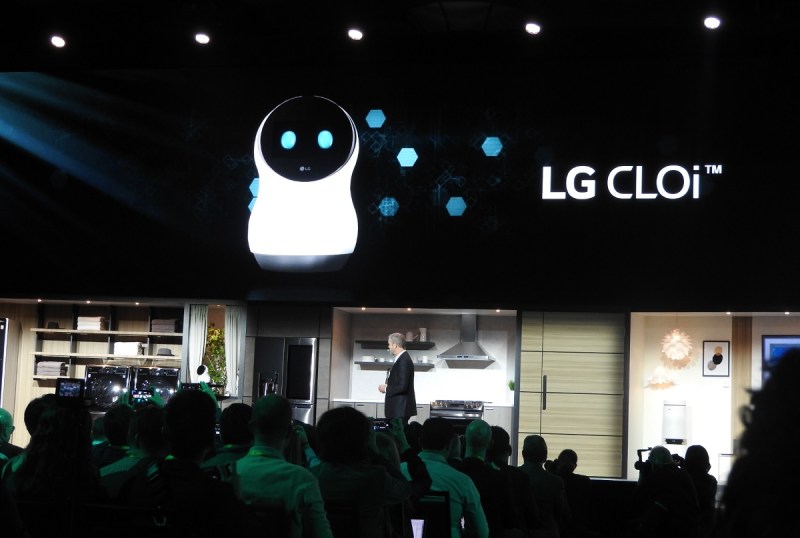
Above: LG Cloi robot refused to obey commands at CES 2018.
VentureBeat: The speed at which you move has become so much more important, it seems like.
Shapiro: We did some digging and we found that the tariffs are now costing our industry $1 billion a month. The problem with that number is I don’t want to encourage the guy. If D.C. gets a billion in new tax revenue–he says the Chinese companies pay, when the truth is the Chinese companies aren’t paying it at all. It’s American consumers and American companies. Very few companies that are not U.S. companies are importing. I’ve heard that from a lot of companies.
The other thing I’ve heard is that a number of companies are talking about investing in moving factory production elsewhere, out of China. A number of people have said things like, “We have responded much more quickly than you would have ever imagined.” But the interesting thing that President Trump might not want to hear is I can’t find any company that’s moved production to the U.S. because of the tariffs. Not one.
VentureBeat: Government action, or inaction, can cause a lot of disruption.
Shapiro: Ironically, responding to government actions is not what I had in mind with Ninja, because usually government actions are signaled. There’s due process. A lot of things occur first. Even the tariffs were signaled, but I’d say a lot of people didn’t believe they would occur. People thought it was a negotiating ploy.
We don’t think it was the best thing to do. We still don’t know what Trump wants. I pushed Larry Kudlow on that. He said, “Don’t you know?” I said, “No. I’ve tried to find out. We don’t know what he wants from China.” Part of me believes that Trump wants to isolate China permanently, but the administration has said that their demands are classified. It’s not clear what they want. Some of this stuff, I don’t even know how China could give it to them. If they want a balance of trade between us, that’s not how economics works.
There’s only one economist who thinks this is a good idea, and that’s the economist in the White House. We have research saying more than 90 percent of economists think this is bad, which was the same thing happening in 1930 when Congress passed Smoot-Hawley, which was the last time our government did something, by all accounts, that was really dumb and led to an exacerbation of the Great Depression. They’re doing it over again. Now we’re in a pause and I hope it’s resolved, but I have no greater insight. I don’t know what they’re really thinking in the White House.
How tech is spreading jobs into the heartland
VentureBeat: The other chapter that caught my attention was this notion of technology spreading out into different regions of the U.S., like with Pittsburgh. We do our own conferences on this, what we call the “tech in the heartland” concept. I visited Pittsburgh and it was astounding to see one of Carnegie Mellon’s entertainment technology buildings, which was built on the site of a former steel mill.
Shapiro: Karen Chupka, who runs CES, is from Pittsburgh. A lot of Pittsburgh people moved to Washington. The Steelers are probably as popular as the Redskins here. But no, Carnegie Mellon is absolutely huge. They have a great strategy.
When you go out into the world everybody wants to be Silicon Valley, and frankly it drives me crazy. Silicon Valley is unique. It has its own strengths. But every part of the world has its own strengths and weaknesses. My point to these people is, don’t try to be what you’re not. Be honest about your strengths and weaknesses and figure out what you can do. Maryland is big on biotech, for example. One-third of the internet traffic in cloud computing is in Virginia.
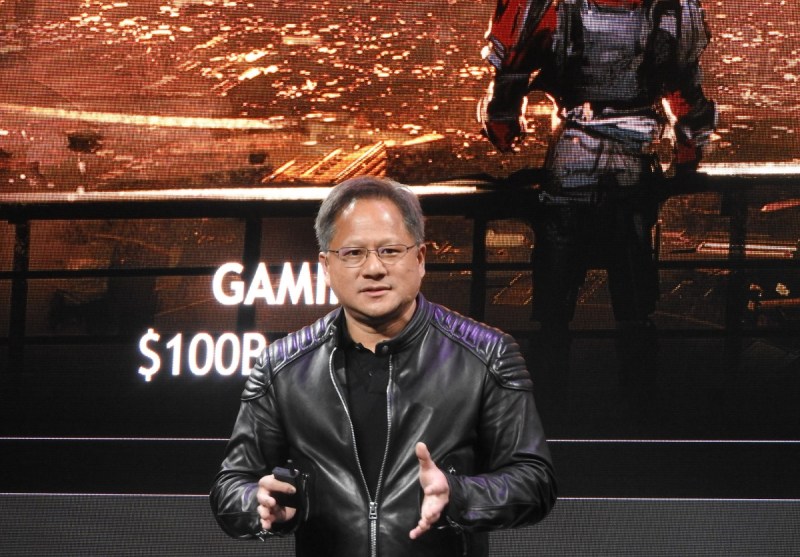
Above: Jensen Huang, CEO of Nvidia, talks about gaming at CES 2018.
One thing we did, though, is we want to encourage good behavior. We rank all 50 states and we try to push them in the right direction. The winners really like it, and what we find now with the losers–state legislatures are looking at it, exactly the way we want them to. That’s why we expanded it globally when we did it in January. It was so successful that we’re updating it and adding countries to it.
The global scorecard is obviously different than the state scorecard. There are rights we have among ourselves as all Americans that other countries don’t have. We score them on some things like that. One of the things we measure on globally is liberty, because we believe liberty encourages innovation. Do you have the right to access the internet? Do you have the right to vote for real choices? Do you have freedom of religion? Do you have the right to marry who you want? We define that as liberty.
If you go to the website you can see all this stuff. It’s all transparent. It’s our view of the world, an American view of the world, but we try to rank these countries. It’s been so successful that we have a number of foreign ministers that will be joining me on the keynote stage that are our champions in foreign countries. The winners, they’re happy with it. The losers, nobody’s really given us a hard time, because we say, “Give us input.” These are our criteria. We didn’t hire anyone to tell us what those should be, although for some of them we used third-party scoring on things like tax policy. Broadband deployment, STEM graduates, diversity. We’re big on diversity. That contributes to innovation.
Trends of 5G, crypto, and blockchain
VentureBeat: Back to things in the book that are also at CES, it seems like very big areas would be 5G, cryptocurrency, and blockchain.
Shapiro: Right. AI is also one of the ingredient technologies at CES. But 5G will be huge. You’ll see the top people. John Donovan of AT&T is keynoting, as is the CEO of Verizon, Hans Vestberg. We have other people focusing on 5G. A lot of the chip companies will be showing things. I expect to see some 5G handsets.
VentureBeat: Crypto and blockchain are interesting so long as they’re not all scams.
Shapiro: I saw that little blip today that with one of these currencies, most of the trades were scam trades. We have blockchain sessions. It’s tough to show blockchain, but it’ll definitely be one of the stories of the show, blockchain applications. I think it’s going to keep growing. I liken it to quantum computing in a way. You’re adding new elements of verification, and it helps preserve your privacy and do all sorts of other things.
On the other hand, last Thursday, our building was one of those hit by–we had to evacuate because one of our tenants got that email. “There’s a bomb in your building. Pay us in Bitcoin.” Probably not my best moment to talk about it, because it makes that kind of stuff–when you hear about how hospitals have been shaken down, like a lot of technologies it has its good and bad sides.
VentureBeat: It works because the hospitals are required by law to keep their data on site. If they get hacked there’s no backup somewhere else.
Shapiro: HIPAA, to me, is not the model I want our privacy rules to follow. I know how difficult it is to do research with HIPAA. Even with electronic medical records, it’s very difficult to share them — not only because of HIPAA, but also because the Affordable Care Act thought they were encouraging electronic medical records, but there are so many different ways of doing it and there’s no incentive for doctors, so they don’t share records. It’s not been great. It didn’t live up to what I thought it would be.

Above: Samsung at CES 2018.
VentureBeat: Any other big things you’d like to point out for the show?
Shapiro: Since you mentioned health technology, for the first time at CES we’re having continuing medical education credits for doctors. The health care portion keeps growing. It’s so important to people. There are so many aspects of it that are different. It’s sports health. It’s health and wellness. We have insurance companies coming now that are involved with us. We have a 22 percent increase in visitors in our health and wellness area. It’s big.
VentureBeat: I like how a lot of detection technology is coming into watches and smartphones now. Blood pressure detection, stroke detection, things like that.
Shapiro: Absolutely. We were looking at our 2018 revisions for our market research projections as we’re introducing our 2019 projections, and one of the revisions upward, rather dramatically, was our smart watches category. Not only because of Apple’s products, but a whole bunch of companies are selling a whole bunch of products. I realized that when my son got a smart watch for Hanukkah. It does a lot more than my FitBit does. It does everything.
The other thing is self-driving cars. The vehicle technology at the show is very big. We’ve expanded that area. There are so many things that play into that, whether it’s 5G or AI. We’ve seen a tremendous growth in 2018. People are getting all these technologies in their cars. They’re asking for these driver assist technology. On the way to the self-driving car, people buying new cars are choosing to pay for these technologies more than we anticipated a year ago. That’s reinforcing Detroit’s enthusiasm, I think, which is interesting.
CES keynotes
VentureBeat: As far as keynotes go, is there anything you would hint at that might be really cool? I think of the one from Carnival Cruise Lines.
Shapiro: Yeah, that was pushing the envelope for us, and it worked out. You may have seen in the book, but I actually visited the ship that does all that. It’s cool in ways that I didn’t anticipate. There are green sides of it, power consumption, other things they’re doing with it.
What Ginni Rometty says about quantum computing, I think that’s something where–there’s not 100 percent certainty we’ll ever get there, but the race is on. People feel that whoever gets there first really has a lot of power, economic power and ability to do stuff. It’s not only a race among U.S. companies. The Chinese are working on it. That’s interesting.
I look forward to hearing about AMD. It’s a company that hasn’t gotten a lot of press or exposure, but all of a sudden their stock shot up a zillion points. It’s fallen back a little bit, but I want to see–the chip companies, to me, are always leading indicators. I always like having a chip company speak, but this is the first time we have AMD speaking.
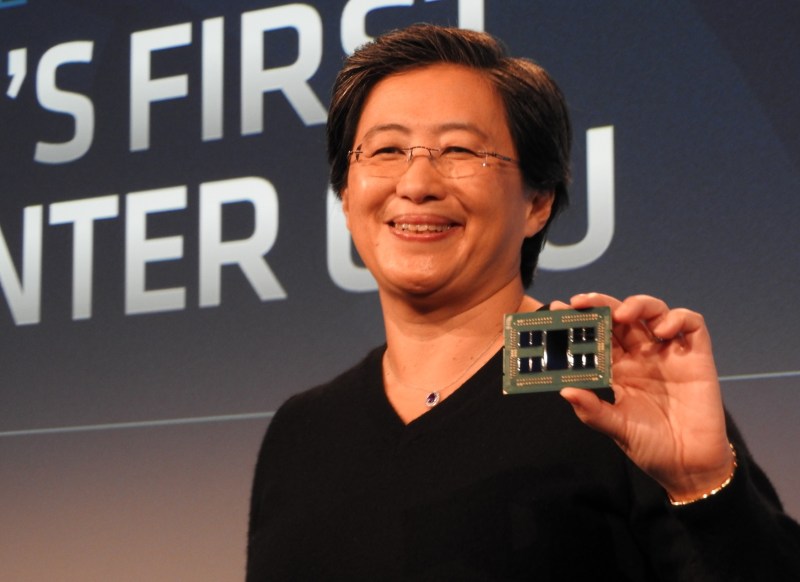
Above: Lisa Su, CEO of AMD, holds an Epyc Rome server module.
I want to hear what Verizon has to say about their 5G plans, because there’s obviously a battle there between Verizon and AT&T. I’m starting to believe that part of the traction for 5G with Verizon is that it’s so expensive to put fiber in the ground. I’m a happy FIOS customer. I think everyone should have it. I’m frustrated that we don’t have it in my Detroit home, because I can feel the difference. I want to see if 5G in some sense becomes the alternative to fiber, to help get that last few hundred yards or whatever it is.
It’s not only the keynotes. There are so many different speakers and panels and things like that. We have Cabinet secretaries and others coming as well that’ll have something to say.
On the FCC and security
VentureBeat: Do you know what you want to talk about with Ajit Pai from the FCC?
Shapiro: I’m a huge fan of his. I think he’s brilliant. I have to admit, there’s a lot of discussion about why he didn’t make it last year. My sympathy was with him. But he did go to Mobile World Congress in Barcelona, and I was a little sad that he felt safer in Barcelona than he felt in the U.S.
VentureBeat: Do you have the same kind of security procedures in place this year?
Shapiro: We’re always looking to improve. That’s one reason we’re pushing people to download the app. Last year we had a separate app for security and safety. You had to download two apps. This year the LiveSafe app is part of the CES app. It’s enhanced in a lot of ways. You can do all sorts of things with it, including–if you see something you can report something. If there’s sexual harassment you can report it. If you want to follow a colleague to make sure they’re safe, they can announce that they’re safe through the app. The app is also geo-fenced in some ways, which provides some benefits. It’ll tell you how to get to places.
In terms of safety and security, I’m not going to go into the exact measures, but we’re very focused on safety and security. We’ve stepped it up, as we do every year. Last year we started with photo ID on the badges. Obviously there are reasons for that that have a lot to do with security, making sure we know if we have any known risky people coming. We work very closely with the Department of Homeland Security and the FBI. All our staff is going through mandatory security training. It’s fair to say we spend a lot of time on it.
